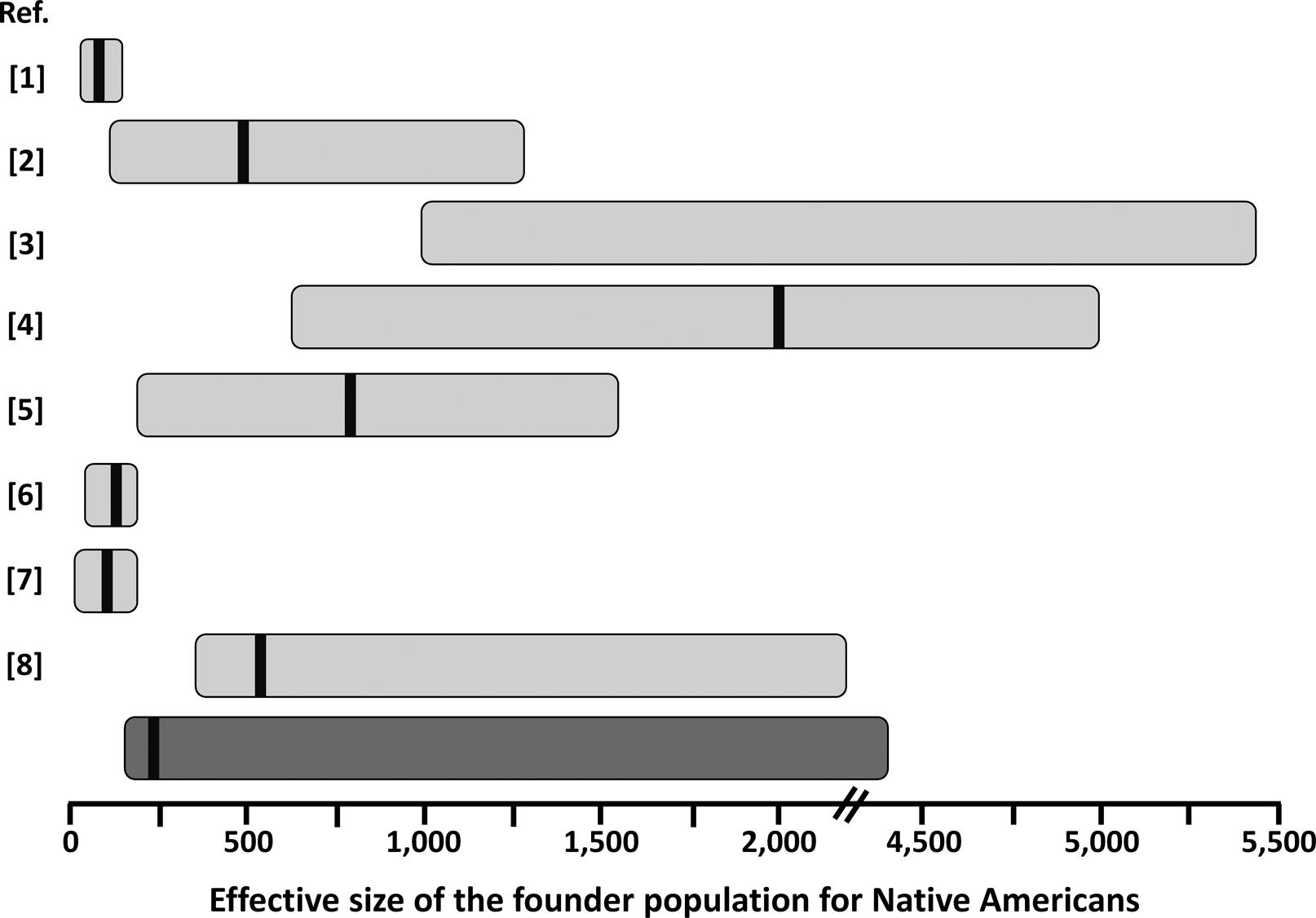Figure 1
Posterior densities for divergence time (years) in all scenarios tested including migration. Divergence between Asian and Native American is shown in solid black, between Chinese and Native American in white with black contour, between Chinese and Siberian in dark gray, and between Siberian vs. Native American in light gray, as shown in the graphical legend.
Figure 2
Posterior densities for the effective sizes of the founder population. The size of the founder population for Native American from Asia is shown in solid black, for Native American from Chinese in light gray, for Siberian from Chinese in white with black contour, and for Native American from Siberian in dark gray, as shown in the graphical legend.
Figure 3
Schematic representation of estimates of the founder population size for Native Americans from this (dark gray bar) and previous (light gray bars) studies. The horizontal bars represent the approximate 95% credible interval for the published values. Point estimates, when reported, are represented by the black vertical bar within the horizontal bars. Please note the discontinuity in the x-axis between 2,000 and 4,500. References (Ref.) are: 1 – Hey (2005)Hey J (2005) On the number of New World founders: A population genetic portrait of the peopling of the Americas. PLoS Biology 3:e193.; 2 – Fagundes et al. (2007)Fagundes NJR, Ray N, Beaumont M, Neuenschwander S, Salzano FM, Bonatto SL and Excoffier L (2007) Statistical evaluation of alternative models of human evolution. Proc Natl Acad Sci U S A 104:17614-17619.; 3 – Kitchen et al. (2008)Kitchen A, Miyamoto MM and Mulligan CJ (2008) A three-stage colonization model for the peopling of the Americas. PLoS One 3:e1596.; 4 – Fagundes et al. (2008)Fagundes NJR, Kanitz R, Eckert R, Valls ACS, Bogo MR, Salzano FM, Smith DG, Silva Jr WA, Zago MA, Ribeiro-dos-Santos AK, et al. (2008) Mitochondrial population genomics supports a single pre-Clovis origin with a coastal route for the peopling of the Americas. Am J Hum Genet 82:583-592.; 5 – Gutenkunst et al. (2009)Gutenkunst RN, Hernandez RD, Williamson SH and Bustamante CD (2009) Inferring the joint demographic history of multiple populations from multidimensional SNP frequency data. PLoS Genet 5:e1000695.; 6 – Ray et al. (2010)Ray N, Wegmann D, Fagundes NJR, Wang S, Ruiz-Linares A and Excoffier L (2010) A statistical evaluation of models for the initial settlement of the American continent emphasizes the importance of gene flow with Asia. Mol Biol Evol 27:337-345.; 7 – Wall et al. (2011)Wall JD, Jiang R, Gignoux C, Chen GK, Eng C, Huntsman S and Marjoram P (2011) Genetic variation in Native Americans, inferred from Latino SNP and resequencing data. Mol Biol Evol 28:2231-2237.; 8 – Gravel et al. (2013)Gravel S, Zakharia F, Moreno-Estrada A, Byrnes JK, Muzzio M, Rodriguez-Flores JL, Kenny EE, Gignoux CR, Maples BK, Guiblet W, et al. (2013) Reconstructing Native American migrations from whole-genome and whole-exome data. PLoS Genet 9:e1004023.. The values presented in Hey (2005)Hey J (2005) On the number of New World founders: A population genetic portrait of the peopling of the Americas. PLoS Biology 3:e193. were recalculated based on a generation time of 25 years.



